
2018下半年小学英语教师资格证面试试题(精选)第二批
时间:2019-10-12 17:37 来源:未知
- 【考试公告】2020年上半年教师资格证考试公告
- 【报名入口】2020年上半年教师资格证报名入口
- 【备考资料】教师资格证笔试资料免费领
- 【公益讲座】教师资格证笔试免费公开课
- 【辅导课程】教师资格证笔试课程
- 【每日一练】每日打卡
小学英语 听说
一、考题回顾
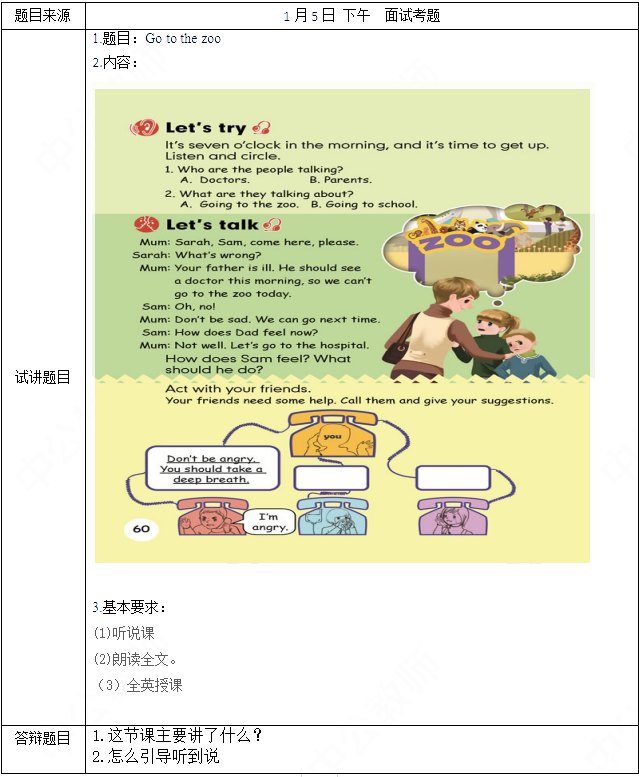
二、考题解析
【教案】
Teaching aims:
Knowledge aim:
Students can master the words: doctor, zoo, and hospital
Ability aim:
Students can improve their skills of listening and speaking.
Emotional aim:
Students can be more interested in taking part in activities and know how to deal with the emergency..
Key and difficult point:
Key Point:master the words: doctor, zoo, and hospital and understand the main topic of this dialogue.
Difficult Point: know how to deal with the emergency in daily life.
Teaching procedure:
Step 1: Warming-up
1. Greetings.
2. Ask students where they went last weekend.
3. Ask students “did you meet any emergency when you had the plan”
Step 2: Pre- listening
1. Draw some pictures to teach about the words: doctor, zoo, and hospital
2. Let students guess what the main topic of passage according to the title
Step 3: While-listening
First listening: check the prediction of main topic of the dialogue and ask”what are they talking about”
Second listening: what’s the matter of Sarah? and what is about his feeling?
Third listening: read after the tape.
Step4: Post-listening
Set a situation: if you meet this situation, what should you do? and if your friend meet this situation and he calls you for help. What will you say?
Step5: Summary and Homework
Summary: ask a student to conclude the content of the lesson and summarize with the whole class.
Homework: ask students to practice the sentence structure learned today with desk mates after class.
Blackboard design:
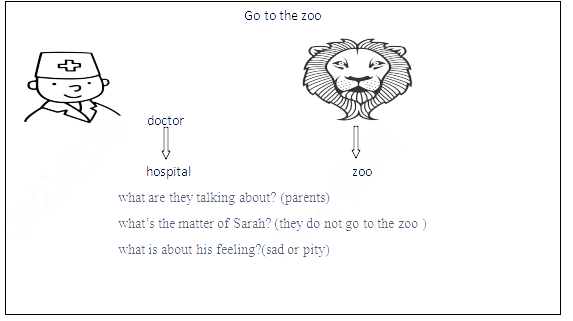
【答辩题目解析】
1.What is the lecture mainly about?
【参考答案】
In this lecture, Sarah meet the situation that his father is ill so they can not go to the zoo and need to go the hospital, so he feels sad and angry . By this lesson, I hope my students can think more about our parents and do not be selfish. I hope my students can think more and think about others in our daily life.
2. How to guide the hearing to say
【参考答案】
In listening and speaking lesson, the speaking and listening are all important. Students need to learn how to speak. Before speaking, I will lay the groundwork. I will teach the words and sentences to clear the obstacles, so the students can be confident in speaking. Listen more to be familiar to the topic is also the good way to make students want to speak.
2018年下半年教师资格面试-英语学科-试讲-考题解析
小学英语 语法
一、考题回顾
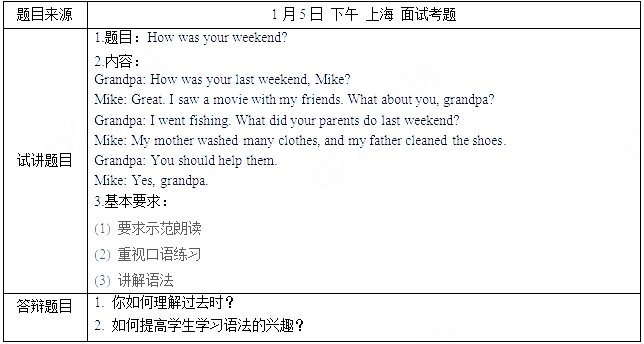
二、考题解析
【教案】
Teaching aims:
Knowledge aim:
Students will grasp the usage of simple past tense.
Ability aim:
Students will improve their speaking ability in describing things happened in the past.
Emotional aim:
Students will be more confident in speaking English.
Students will arouse their interest in learning oral English.
Key and difficult point:
Key Point:
Students will grasp the usage of simple past tense.
Students will improve their speaking ability in describing things happened in the past.
Difficult Point:
Students will be more confident in speaking English.
Students will arouse their interest in learning oral English.
Teaching procedure:
Step 1: Warming-up
1. Greetings. Talk about the weather.
2. Sing a song called Yesterday Once More, and introduce today’s topic.
Step 2: Presentation
1. Read the dialogue by the teacher, and ask what the dialogue is about.
2. Let the students open the book and read it for the second time, then ask the students to circle the verb in it and ask the similarities among them. They may say that they are different from the verbs they learned. “-ed” is added in some verbs at the end.
3. Tell them that simple past tense is a tense that is used to describe things happened in the past. When we apply it, you should change the verb into past tense. Then introduce the regular and irregular verbs.
Step 3: Practice
1. Fill in the blanks.
a. I _____(clean) the table after we had lunch last evening.
b. My father_____(go) to the company yesterday.
Step 4: Production
1. Make a dialogue with their deskmates about what the students did last weekend. Then invite some students to share their dialogue with their parents.
2. Ask the students to make up a simple story or a joke. Then invite some students to share it with us.
Step5: Summary and Homework
Summary: make a brief summary of what we have learned today.
Homework: Tell the story or the joke to their parents.
Blackboard design:
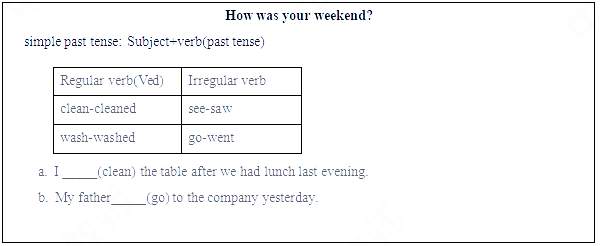
【答辩题目解析】
1. Please talk about your understanding of simple past tense.
【参考答案】
Simple past tense is a tense used to describe things happened in the past. When we use it, we need to change the verb into past tense. The verbs are changed in regular form or regular form. Regular verb only needs to add -ed at the end of a word, while irregular verbs have various forms. I will now show an example: My friend looked at me when I touched him. So that’s my understanding of simple past tense.
2. How do you stimulate students’ interest in learning grammar?
【参考答案】
Grammar can be a little boring for students. But it is essential to learn English. So different activities can be arranged to attract their attention. For example, in the warming-up, I sang a song called Yesterday Once More so that they will know this grammar point is around us and frequently used. Then, in the presentation part, I will let the students take the initiative to find the rules of simple past tense. At last, I asked students to talk about their daily lives and share stories or jokes with simple past tense, so they will use the tense and do not get bored with much mechanical drilling. So I believe they will be interested in my grammar lesson.
2019年下半年教师资格面试-英语学科-试讲-考题解析
小学英语 阅读
一、考题回顾
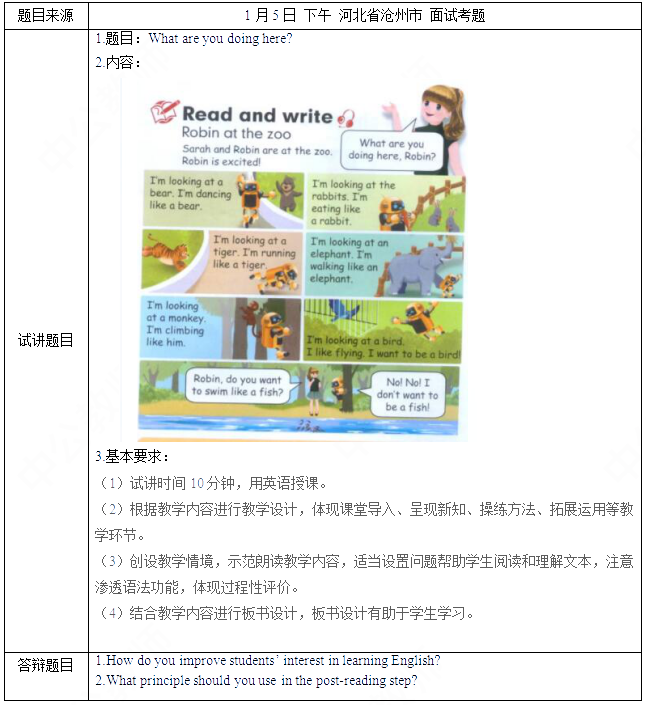
二、考题解析
【教学设计】
Teaching aims:
Knowledge aim:
Students will master the meaning and usage of the structure “be doing” through reading the passage.
Ability aim:
Students will apply the “be doing” to communicate with each other in real situation.
Emotional aim:
Students will be more interest in learning English.
Key and difficult point:
Key Point: Students will master how to improve reading abilities through finding main idea and details.
Difficult Point: Students will apply the “be doing” to communicate with each other in real situation.
Teaching procedure:
Step 1: Warming-up
1. Greetings.
2. Play a riddle and students guess the animals, such as “long nose, big ears and strong body——elephant”, then lead to the topic of “let’s go to the zoo to see what animals are doing”.
Step 2: Pre-reading
1. According to the title, students have a prediction about what kinds of animals are mentioned in the passage.
Step 3: While-reading
1. Fast reading: students read the passage fast and figure out what kinds of animals are mentioned in the passage then make a list.
2. Careful reading: students read the passage carefully and answer the question: what are the animals doing? Then fill in the blanks.
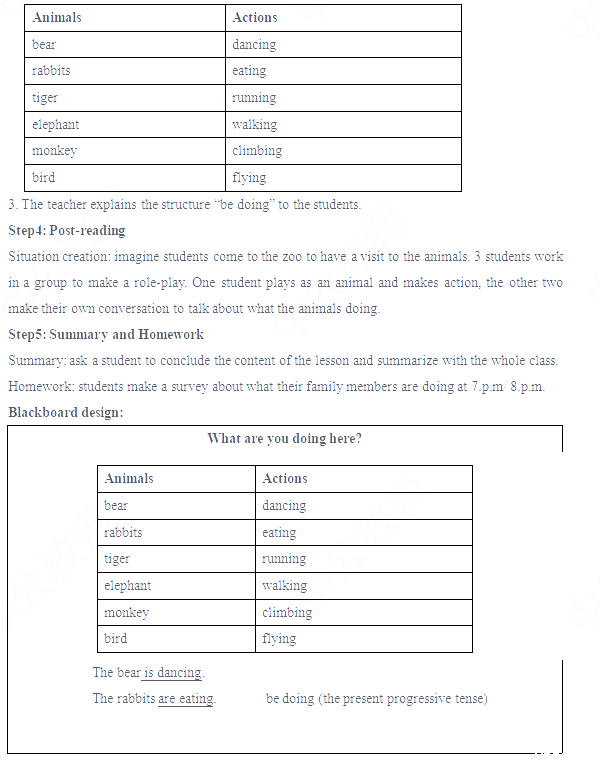
【答辩解析】
1. How do you improve students’ interest in learning English?
【参考答案】
In the process of English teaching, teachers should enrich the teaching approaches, not only teach students through "listening, speaking, reading", but also integrate situational teaching, so that students can feel the diversity of teaching and learning.
Besides, teachers can make use of the form of cooperative study and organize various practice activities in the classroom to create an atmosphere of mutual assistance and cooperation, so that students have positive sense of learning.
2. What principle should you use in the post-reading step?
【参考答案】
First, we should persist in the communicative principle. In the production step of reading
class, students should be organized in groups to cultivate their speaking ability and communicative ability. In this way, we can reach the New Curriculum Standard.
Then, we should insist on the truth principle. That means we should provide more real materials that are closet to students’ real life, such as situation creation like what I did in this class. In this way, students’ interest can be aroused and they can apply what they’ve learned in real communication.
(责任编辑:admin)















